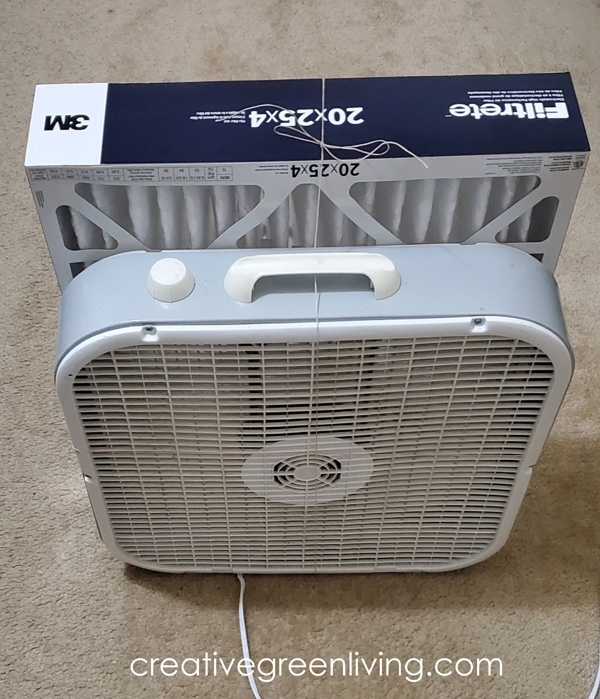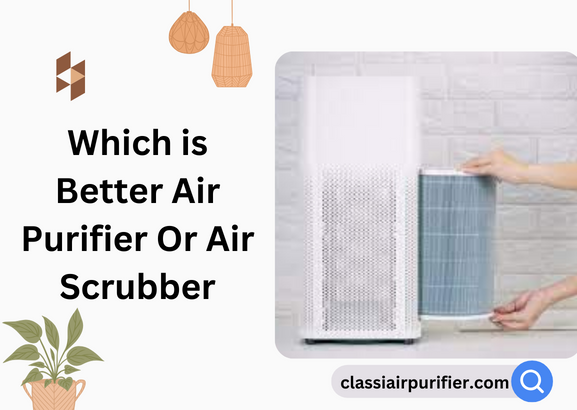If you want to improve the quality of the air in your home, one option is to use a DIY air purifier. This can be a simple and effective way to remove contaminants from the air, and it can be done using materials that you may already have around your home. You will need a clean, empty plastic bottle, some activated carbon, and a piece of cloth or paper.
Cut the bottom off of the bottle, and then cut a small hole in the top. Cover the hole with cloth or paper, and then secure it in place with tape. Pour the activated carbon into the bottle, and then add water until it is about halfway full.
Place the bottle upside down in a bowl or container. The water will act as a filter, and the activated carbon will absorb impurities from the air.
- Cut a hole in the top of your chosen container
- Cut a hole in the side of your container, slightly smaller than the hole in the top
- Insert your air filter into the larger hole in the top of the container
- Cover the air filter with mesh or fabric to keep dust and debris out
- Place your fan over the smaller hole in the side of the container, pointing inward toward the air filter
- Turn on your fan and enjoy clean, purified air!

Credit: www.youtube.com
How Do I Naturally Purify the Air in My House?
Most people are aware of the importance of indoor air quality, but many don’t know how to improve it. There are a few simple things you can do to naturally purify the air in your home and create a healthier environment for your family. One way to naturally purify the air in your home is to bring plants inside.
Plants help to filter out harmful toxins and pollutants from the air, while also releasing oxygen. Some of the best plants for purifying indoor air include spider plants, aloe vera, ficus trees, and peace lilies. Place these plants around your home in areas where you spend most of your time.
Another way to naturally purify the indoor air is by opening up your windows on a regular basis. This allows fresh air to circulate throughout your home and helps to remove any stale or polluted air that may be trapped inside. Just be sure to open up windows when it’s not too hot or cold outside so that you don’t let all the heat or AC escape!
Finally, make sure you’re regularly cleaning your floors and surfaces with natural products. Chemical-based cleaners can actually contribute to poor indoor air quality, so opt for more natural options like vinegar, baking soda, or essential oils instead. Regular dusting and vacuuming will also help keep the air clean and free from allergens like dust mites and pollen.
Is Diy Air Purifier Effective?
Yes, DIY air purifiers can be effective at improving indoor air quality. While commercial units may be more powerful, DIY air purifiers can still make a noticeable difference, especially if you are concerned about specific pollutants like smoke, dust, or pet dander. To get the most out of your DIY unit, make sure to choose the right size for your space and use high-quality filters.
How Do You Make Your Own Air Cleaner?
When it comes to improving the quality of the air in your home, an air purifier can be a helpful addition. But what if you don’t want to buy an air purifier? Can you make your own?
Here are some tips to choose an air purifier:
1. Get a plant: Plants help improve indoor air quality by absorbing carbon dioxide and releasing oxygen.
They also act as natural filters, trapping pollutants like dust, mold, and bacteria in their leaves and roots. Choose plants that are known for their ability to improve indoor air quality, such as spider plants, peace lilies, or rubber trees.
2. Make a DIY charcoal filter: Charcoal is known for its ability to absorb impurities and odors. You can make your own activated charcoal filter by placing charcoal briquettes in a coffee filter or piece of cloth and securing it with a rubber band. Place the filter in front of an open window to help remove pollutants from outdoor air before they enter your home.
3. Use essential oils: Certain essential oils have cleansing properties that can help improve the quality of the air in your home when used with a diffuser. Some good options include lemon, lavender, eucalyptus, and tea tree oil.
4. Create positive ions: Negative ions are particles that bind with pollutants like dust, mold, and bacteria, making them too heavy to stay airborne. You can create negative ions by using salt lamps, ionizers, or even running water.
5. Bring in some fresh air: One of the best ways to improve indoor air quality is simply by ventilating your home and letting fresh outdoor air circulate throughout. Open windows whenever possible and use fans to promote airflow.
What Materials Do You Need to Make an Air Purifier?
There are many different types of air purifiers on the market, but they all work by trapping particles in the filter and allowing clean air to pass through. To make your own air purifier, you will need a few supplies.
First, you will need a box fan. Box fans are inexpensive and can be found at most hardware stores. Next, you will need some sort of filter material.
This can be anything from furnace filters to coffee filters. You will also need some duct tape and scissors. The first step is to cut a hole in the center of the box fan using scissors.
The hole should be big enough to fit the filter material snugly. Once the hole is cut, attach the filter material to the fan using duct tape. Make sure that there are no gaps around the edges of the filter so that all of the polluted air will be sucked into it.
Now, turn on your fan and enjoy breathing easier knowing that harmful particles have been removed from the air!
How to Make a DIY Air Purifier
Diy Air Purifier for Smoke
If you’re looking for a way to purify the air in your home and get rid of smoke, a DIY air purifier may be the answer. There are many different designs and methods that you can use to build your own air purifier, so it’s important to do some research and find the one that best suits your needs. One popular design is the activated carbon filter, which uses charcoal to absorb impurities from the air.
This type of filter can be made using a coffee can or other container, and all you need is some activated carbon, a piece of cloth, and some duct tape. Simply place the carbon in the bottom of the container, cover it with the cloth, and secure it with duct tape. Then cut a hole in the top of the container and insert an exhaust fan.
The fan will draw air through the carbon filter and help to remove smoke and other pollutants from your home. Another option is an ozone generator, which uses electricity to create ozone gas. Ozone is a powerful oxidizer that can neutralize many types of pollutants, including smoke particles.
You can purchase an ozone generator online or at most hardware stores. Be sure to follow all safety instructions when using this type of device, as ozone gas can be harmful if inhaled in high concentrations. If you’re concerned about indoor air quality but don’t want to spend money on commercial products or hire someone to install an expensive system, consider building your own DIY air purifier.
With a little time and effort, you can create a device that will help keep your home smoke-free and clean.
Do Homemade Air Purifiers Work
If you’re looking for a way to improve the air quality in your home, you may be wondering if homemade air purifiers work. The answer is yes! There are several DIY air purifier options that can help to remove contaminants from the air and improve your indoor air quality.
One option is to make a DIY activated carbon filter. Activated carbon filters are known for their ability to absorb pollutants and contaminants from the air. To make your own activated carbon filter, start by cutting a piece of charcoal into small pieces.
Then, place the charcoal pieces in a coffee filter or cheesecloth and secure with a rubber band. Hang the filter in an area of your home where there is good airflow and let it work its magic! Another option for a homemade air purifier is an ionizer.
Ionizers work by charging particles in the air and then attracting them to metal plates or collector screens. This helps to remove particles like dust, pollen, smoke, and pet dander from the air. You can purchase an ionizer or make your own using a negative ion generator (NIG).
Homemade air purifiers are a great way to improve indoor air quality without breaking the bank. Give one of these DIY options a try today!
Best Diy Air Purifier
If you are looking for an air purifier that will remove all the pollutants from your home, you should consider buying a DIY air purifier. These devices are designed to remove all the airborne particles that can cause health problems. However, before you buy one of these devices, it is important to know what they do and how they work.
How do Air Purifiers Work? Air purifiers work by trapping the contaminants in a filter and then releasing clean air back into the room. The most common type of air purifier uses an activated carbon filter to trap the contaminants.
This type of filter is very effective at removing harmful chemicals, VOCs, smoke, and odors from the air. Activated carbon filters are also good at removing large particles such as dust and pollen. HEPA filters are another type of filter that is often used in air purifiers.
These filters are designed to remove 99.97% of all particles that are 0.3 microns or larger from the air. HEPA filters are very effective at removing allergens, bacteria, viruses, and mold spores from the air.
Air Purifier for Dust
If you’re looking to improve the air quality in your home and remove dust particles, an air purifier is a great option. Dust can contain a variety of harmful particles including pollen, pet dander, and dust mites. An air purifier can help remove these particles from the air, providing you with cleaner air to breathe.
There are a few things to consider when purchasing an air purifier for dust removal. First, consider the size of the unit. You’ll want to choose an air purifier that’s appropriately sized for the room or area you plan on using it in.
A larger unit will be more effective at removing dust from the air, but it will also be more expensive and use more energy. Next, think about the features you need. Some units come with special filters for removing specific types of particles like smoke or chemicals.
Others have variable speed settings so you can adjust how much airflow they produce. Consider what features are most important to you before making your purchase. Finally, take into account your budget.
Air purifiers range in price from around $50 to over $1,000 depending on their size and features.
Diy Air Filter Box
If you suffer from allergies, you know how important it is to have a clean air filter in your home. But did you know that you can make your own air filter box? It’s easy and inexpensive, and it will help keep your home free of allergens.
Here’s what you’ll need:
– A cardboard box (shoe boxes work well)
– A piece of cheesecloth or other breathable fabric
– enough to cover the inside of the box with an additional inch or two of space on all sides
– Stapler and staples
– Air filter material
– I like to use HEPA filters, but any type of air filter will work
– Tape measure
First, cut a hole in one end of the box. The hole should be big enough to fit your air filter material snugly. Next, cover the inside of the box with cheesecloth or other fabric.
Ensure that the fabric is free of any openings or punctures. Then, staple the fabric in place around the edges of the box. Now it’s time to add your air filter material.
Cut it to size so that it fits snugly into the hole you cut earlier. Once it’s in place, secure it with tape so that it doesn’t come out. That’s all there is to it!
Your new DIY air filter box will help keep allergens out of your home while saving you money on replacement filters.
Diy Air Filter Material
One of the most important things you can do to improve the quality of your indoor air is to regularly replace your home’s air filter. A high-quality air filter will capture many of the airborne contaminants that can cause respiratory problems, allergies, and other health issues. There are a number of different types of air filters available on the market, but if you’re looking for a DIY option, you can easily make your own air filter using materials like activated charcoal, coffee filters, and even old t-shirts.
Activated charcoal is one of the most effective materials for trapping airborne contaminants. It’s often used in commercial air filters and can be easily made at home by heating regular charcoal in an oven until it becomes black and porous. Coffee filters are another good option for making a DIY air filter.
They’re not as effective as activated charcoal, but they can still trap many harmful particles. You can either use them on their own or combine them with other materials like cotton balls or pieces of fabric. Old t-shirts or other pieces of fabric make great DIY air filters because they’re easy to find and inexpensive.
Just cut them into small squares and place them over an open container full of activated charcoal or coffee filters. The fabric will help trap smaller particles that might otherwise slip through the holes in the charcoal or coffee filters.
Diy Air Purifier Covid
When the COVID-19 pandemic hit, people were scrambling to find ways to protect themselves and their families from the virus. One of the products that became popular was the air purifier. Air purifiers can help remove contaminants from the air, including viruses, bacteria, and other airborne particles.
There are a number of different types of air purifiers on the market, but not all of them are effective against COVID-19. In order to choose an air purifier that will help protect you from the virus, there are a few things you need to keep in mind. First, you need to make sure that the air purifier you select is capable of removing small particles from the air.
The smaller the particle, the more likely it is to contain a virus or other pathogen. Most standard HEPA filters can remove particles as small as 0.3 microns, which is small enough to capture most viruses. Second, you need to choose an air purifier with high CADR ratings.
CADR stands for clean air delivery rate and measures how much-purified air an appliance produces per minute. The higher the CADR rating, the better an appliance will perform at cleaning your indoor air. Choose an air purifier with high CADR ratings for each of the three main airborne contaminants: smoke, dust, and pollen.
Finally, consider choosing an ultraviolet (UV) light air purifier in addition to or instead of a traditional filter-based model. UV light can kill viruses and bacteria on contact, making it an effective way to combat COVID-19. However, UV light can also be harmful to humans if used improperly, so make sure you read all instructions carefully before using any UV light appliance.
Conclusion
The best way to improve the quality of the air in your home is to install an air purifier. But if you don’t want to spend the money on a store-bought model, you can easily make your own with a few household items. To make a DIY air purifier, you’ll need a box fan, an air filter, and some duct tape.
Simply attach the air filter to the front of the box fan using duct tape, and turn it on. The fan will pull polluted air through the filter and release clean air into your room. You can experiment with different types of filters to see which works best for your needs.
Activated charcoal filters are great for removing odors, while HEPA filters can trap smaller particles like dust and pollen. Whichever type of filter you use, be sure to change it regularly so that it continues to work effectively.



